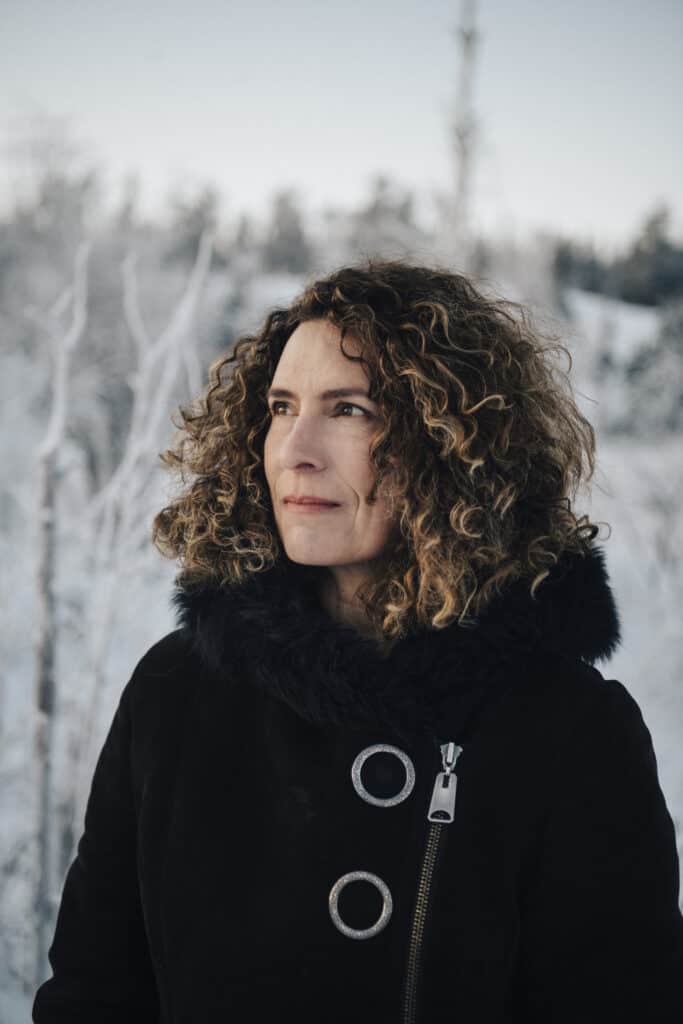By Laurie Sarkadi
“Do not go where the path may lead, go instead where there is no path and leave a
trail.” A friend has this aphorism on a plaque with a drawing of a hiker in a forest, and,
metaphors aside, I hate it.
Where I live, in an off-grid house perched on a slab of ancient bedrock, hemmed on
three sides by a drinkable lake in Chief Drygeese Territory of the Subarctic, there are
boundless options to blaze a trail. I can walk any direction in winter over frozen lakes
and rivers of the taiga with few man-made obstructions, unless I go about 30 kilometres
west and jag south to the capital of the Northwest Territories, Yellowknife. Near this
surprisingly metropolitan city of 20,000 there’s also the infamous and highly
contaminated former Giant Mine site, which destroyed Dene traditional lands, water and
lives, in exchange for gold.
In part because of such toxic legacies, I suffer from a type of environmental affliction,
maybe a neurosis, that wants everything in nature to have the greatest chance possible
of living out its days, its cycles, without human intervention. In other words, naturally. I
know that we are intrinsically a part of nature and therefore bound to make our marks –
Buddhists, and physicists, aptly point out the law of action and reaction is constantly at
play – but few could argue that once a natural space becomes accessible in North
America, humans overreach.
There is a well-worn trail I follow almost daily near my house. Because I have a terrible
sense of direction and often use walking to sort out problems, head down, instead of
mindfully taking in my surroundings, I’m happy to follow a footpath. It was my husband
who one day pointed out a tall majestic tree just off the trail – a jackpine, long dead, its
trunk twisted like metal cables and weathered a stately silver-grey. Tangles of dried
branches and cones extended on either side like arms. Its top looked like a straggly
mop of hair.
My husband called it a condo. About a dozen holes had been pecked or chewed up and
down the trunk, giving sustenance and sanctuary over the years to birds and animals
like woodpeckers, grouse, hawks, owls, voles, squirrels, marten, flickers, bufflehead
ducks…as well as countless insects.
Uncharacteristically – because we don’t really have meadows in this low-lying region of
boreal forest – the tree was in the middle of a large circular clearing carpeted with pale
yellow-green lichen, alone, save for a hunk of granite the size of a large headstone that
stood like a sentry at its base. I could imagine this tree coming to life Disney-like to hold
court while creatures of the forest gathered ‘round. If I were scouting an ideal movie
location to shoot a coven gathering, this would be it. The space took on a quality of the
sacred for me.
I took heed of that tree every walk thereafter, careful not to stray off the trail too often for
a closer look so I wouldn’t stomp a new path through the lichen or the snow and alert
others to its location. A lot of people here heat with wood stoves, including us, and this
dense, near-petrified standing dead would be a valuable commodity.
That summer I noticed flagging tape and some other old trees further down had been
cut to clear what I think was going to become a quad trail. If you build a quad trail,
quads will come. The slow-growing, fragile forest floor would not recover from this
scraping. The cranberries, the mating pair of osprey, everything dependent on this
ecosystem being intact, would suffer. I made some inquiries, expressed some concerns,
and the work quietly stopped.
The next time I walked that trail was after several months away from home to attend
school in Guelph, where I grew up. I was shocked to discover the tree had fallen. I
shouldn’t have been, it’s what dead trees do when left alone. Still, I grieved a little. But
then I noticed how completely at home it looked cradled in a bed of lichen on the forest
floor, offering up its hollowed carcass for a new generation of inhabitants, all of whom
would aid in its degradation towards becoming soil and nurturing new growth.
Sticking to the trails is how the Dene safely navigated annual portages to the
Barrenlands, a treeless landscape rutted with veiny lines from the once-thundering
herds of migrating caribou. It’s how the Bruce Peninsula can be enjoyed, given that
trails crisscross over 700 private and public landholdings on traditional and treaty First
Nations territories. And it’s how a centuries-old dead tree near me might have a better
chance of offering condo life to the locals, because it’s not just people who deserve a
decent place to live.

Laurie Sarkadi is an award-winning journalist, producer and singer-songwriter who lives on Chief Drygeese traditional territory near Yellowknife, Northwest Territories. She is the author of Voice in the Wild, a memoir (Caitlin Press). This article first appeared in “The Blue Print Newsletter Summer 2023”, an online publication for the Bruce Trail Conservancy in Ontario. lauriesarkadi.com